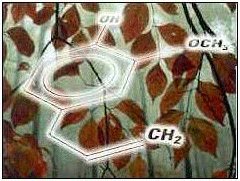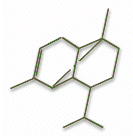Aromatherapy and the Chemistry of Essential Oils
The powerful potential of aromatic molecules on your health
Have you ever brought an essential oil home from your health food store, eagerly anticipating a wonderful, restorative experience, only to be sorely disappointed? Like, “What’s going on here? I thought aromatherapy was supposed to be God’s gift to mankind, or something.”
If that’s your experience, you’re by no means alone. But there’s a reason for this:
→ Effective aromatherapy begins with truly great oils. If your oils are not therapeutic-grade (and if you got them at a health food store, I can pretty much guarantee you that they are not), you simply won’t see the results you’re hoping for.

And, while a therapeutic-grade essential oil will be noted for its fragrance and frequency, it’s the powerful potential of the oil’s aromatic molecules — its chemistry — that sets aromatherapy apart as a truly superior support to your health and wellness goals.
Essential oil chemistry: A delicate mosaic of aromatic molecules
Essential oils are far from simple substances. In fact, few people appreciate how chemically complex essential oils really are.
Every essential oil contains an amazing array — a delicate mosaic — of aromatic molecules. They give the oil its powerful potential for healing. They are also what gives it its distinctive fragrance and its energizing frequency. And, while fragrance itself can have profound effects upon our emotions, these aromatic molecules, because of their chemical make-up, have many other effects, as well.
Essential oil chemistry and its therapeutic effects

As of 1995, chemists have identified more than 3,000 aromatic molecules. Each of these has specific therapeutic actions upon the body. However, the practice of aromatherapy isn’t as simple as applying an oil that contains a specific chemical constituent, in order to achieve a particular therapeutic effect.
Why?
Because, the complexity of an essential oil, with the interplay of its many constituents, means that there is no straight line between the activity of one of its components and the effects of the complete oil.
Even a fairly simple essential oil may contain anywhere from 80 to 300 different chemical constituents. An essential oil like lavender is far more complex. Many of an oil’s constituents occur in very minute quantities; but, all contribute important qualities to the oil, having a synergistic impact on its therapeutic effects.1
Many of these chemical compounds have been identified, and new ones are being discovered; but, many still remain unknown, and the relationships between them are not well understood. However, these molecules can be grouped together into families, each with its own therapeutic properties. Representative of this is the following chart.
| Key Chemical Constituents in Essential Oils and Their Effects | ||
| Constituent | Representative Oil | Effect |
| Ketones | Peppermint | Promotes healthy respiratory function and clear breathing |
| Aldehydes | Melissa | Calming |
| Esters | Lavender | Balancing, calming, relaxing |
| Alcohols | Cassia | Promotes circulation, uplifting |
| Phenols | Oregano | Stimulant, antioxidant, immune-enhancing benefits |
| Monoterpenes | Sandalwood | Enhances mood, promotes healthy, smooth skin |
| Sequiterpenes | Myrrh | Promotes emotional balance and well-being |
| Oxides | Eucalyptus radiata | Assists with clear breathing |
Different therapeutic actions of chemical constituents
Chemically, essential oils are very heterogeneous, giving the same oil many diverse effects within the body. A single essential oil can play many different therapeutic roles. This is very different than the effects of synthetic chemicals, which have only a single action.
The therapeutic action of essential oils preserves the body’s natural balance
Because of their chemical complexity, essential oils don’t disturb the body’s natural balance — or homeostasis. If one constituent exerts too strong an effect in one direction, another constituent may block or counteract it. For example: certain aromatic molecules in an oil may be very stimulating — both psychologically and physically. But, the same essential oil may also contain constituents that are calming and sedating, helping to overcome anxious feelings or agitation.
And, because the oils are natural substances, they tend to go only where they’re needed, and provide only the action needed to help restore the body’s natural balance. The same oil may have significantly different effects on a person from one application to the next, depending on his/her need at that moment. This quality of essential oils makes aromatherapy very safe and, incidentally, makes choosing the right oil less problematic.
This is in stark contrast to synthetic chemicals, which often interrupt the body’s homeostasis, forcing an action based upon the chemical’s make-up, not on what the body needs.
Another interesting point: While it’s possible to duplicate these chemical constituents in the laboratory and blend them together into a concoction that smells like an essential oil, scientists have yet to duplicate the therapeutic effects of a truly therapeutic-grade essential oil.
1 With any therapeutic-grade essential oil, the major portion of it (about 99.99%) is composed of only three elements: carbon, hydrogen and oxygen. Sometimes, however, sulfur and nitrogen also contribute key roles. For example, the distinctive fragrance of grapefruit oil (Citrus X paradisi) is due to a sulfur compound (1-p-menthen-8-thiol) in a tiny trace amount — an infinitesimal 0.0000001%. While proportionally a very insignificant part of the oil, as a whole, its presence dominates the scent of grapefruit. It is also responsible for many of the therapeutic actions unique to grapefruit oil.
In contrast to this, although grapefruit oil is 95% d-limonene, that is not what we smell. D-limonene, in any concentration, is experienced as a faint orange-like aroma. Amazing as it seems, that one molecule in a billion of the sulfur compound is so strong, it overcomes the d-limonene, and is easily picked up and distinguished by our noses.
Adapted from an article by David Stewart, Ph.D., R.A. Used by permission.
